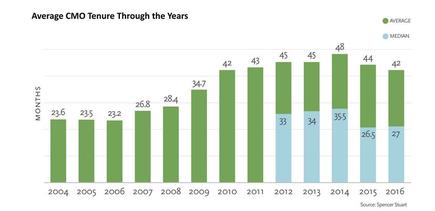Report: CMO tenure declines again
- 27 March, 2017 11:35

The latest into CMO average tenure reports yet another decline in the time chief marketing officers are spending in their roles.
The 14th annual Spencer Stuart CMO tenure study, based on research into the CMOs from 100 of the top US most advertised brands in 2016 showed average tenure dropped from 44 months to 42 months, a decline of six months, or 13 per cent, over the past two years.
However, the study also analysed the median tenure of CMOs and saw a slight increase in tenure to 27 months in 2016, up from 26.5 months in 2015.
Overall, 48 per cent of CMOs have been in their role for no more than two years, a figure that’s consistent with that reported the previous year. The largest percentage (32 per cent) had been in their roles between 13 and 24 months.
There was also a dip in the number of CMOs who have been in their role for at least three years (34 per cent in 2016 versus 41 per cent in 2015 and 49 per cent in 2014).

Across the 16 new CMOs reported on this year, Spencer Stuart noted a number of trends. The first was that the new recruits were more likely to be female or promoted from within, than the overall group of 98 sitting marketing chiefs. For example, the report found 63 per cent of the new CMOs were making their debut in the top job, versus 70 per cent of the overall group surveyed.
In addition, five of the new CMOs are female, compared with 23 per cent of the total pack, and 69 per cent of the new recruits were promoted from within, versus 61 per cent of all CMOs.
For Spencer Stuart’s Marketing Officer Practice consultant, Greg Welch, the data is indicative of the pressure CMOs are under to deliver quick results.
“Even the new breed of marketers must step up to provide immediate leadership,” he commented. “Learning to be an innovative and confident leader is a must, but CMOs also need to provide organisations with a mature and calming voice, regardless of how long they have been ion the role.
“The most successful CMOs quickly establish credibility and get others to believe – and then follow.”
On the subject of gender and diversity, Welsh said the best companies are recognising their importance and putting in appropriate structures to further develop the next generation of marketers that reflect such a diverse world.
“Simply put, we continue to believe that diverse teams yield better results,” he said. “It is our hope that new appointments in the upcoming year are more promising on this front.”
Spencer Stuart isn’t the only one to notice the short tenure of marketing chiefs. In a recent survey conducted by Russell Reynolds Associates of 175 top and notable US companies, half of the 30 retailers studied had turned over their CMO in the previous 12 months. 2016 also saw the highest level of marketing leader appointments and turnover since tracking began four years earlier.
In addition, in recent conducted across the CMO50, we found 14 of the 50 marketers profiled in our inaugural list had either left their position, were promoted locally or globally, or gained new and expanded responsibility between the 2015 and 2016 lists.
As former Westfield director of marketing, John Batistich, pointed out, there is no other role whose careers and responsibilities have changed so dramatically as the CMO’s.
“There is increased complexity, less resources and a need for higher speed with less time,” he told CMO in an interview last year. “There’s pressure and expectations around these roles as a result.”
Follow CMO on Twitter: @CMOAustralia, take part in the CMO conversation on LinkedIn: CMO ANZ, join us on Facebook: https://www.facebook.com/CMOAustralia, or check us out on Google+:google.com/+CmoAu

